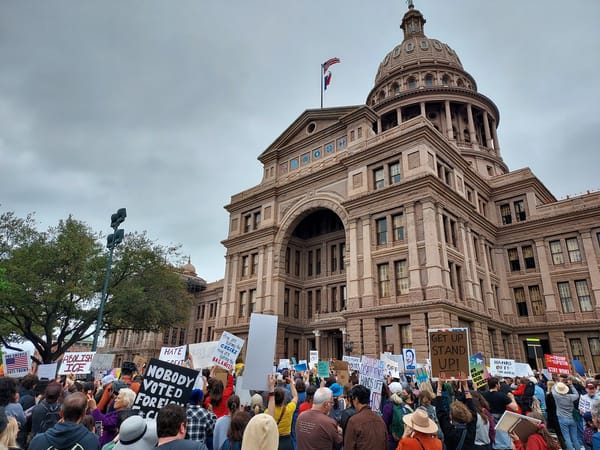It Will Take More Than Abolishing Bad Laws to Fix Land Use in America

We should abolish the National Environmental Policy Act. Nobody is saying this—but a lot of people are walking right up to saying it. This is understandable, given that “we should abolish the National Environmental Policy Act” sounds like something a Captain Planet villain would say. But it is the inevitable conclusion of a style of argument driven, first and foremost, by a clear-eyed recognition of the climate crisis bearing down on us. NEPA lawsuits have been used to block or delay offshore wind farms, solar farms, power relays for hydroelectric plants, and a wide array of other green energy projects. NEPA has served to lock the status quo in place, and the status quo is untenable.
But it’s not just NEPA, and it’s not just climate. In these times it feels like we are roiled by a whole array of different crises: climate catastrophe, infrastructure paralysis, the housing crisis, and the persistence of racial segregation. But each of these crises is in fact a reflection of a single problem: a thicket of regulations that serve, at every level, to block change and preserve the interests of existing homeowners. These regulations enable homeowners to block new housing, to run up the costs of new infrastructure, to prevent the shift to renewable energy, all in the service of maintaining segregated enclaves and their financial interest in skyrocketing housing prices. They keep us locked in a pattern of sprawl, segregation, economic stagnation, and climate catastrophe.
It’s important to take a moment and get into the specifics here. Research is increasingly converging on the idea that these regulations’ most harmful effects are due to “citizen voice”: the capacity of private individuals to block development through lawsuits, public hearings, and similar mechanisms. The levers we have made available for the public to express their voice are almost completely captured by a specific interest: wealthy anti-development (and frequently pro-segregation) homeowners. Showing up at a four-hour town hall meeting on Tuesday at 1pm that’s going to spend three hours going over the minutes of the last meeting before spending another three hours on public comment is the sort of political engagement that most people simply do not or cannot engage in. Filing endless California Environmental Quality Act appeals, while not as expensive as responding to endless CEQA appeals, is nevertheless a relatively expensive legal pastime that only the wealthy and the committed can engage in. While these forms of public voice were intended to protect everyone, in practice they serve almost exclusively to block development and displace costs onto other communities less able to engage them.
If you’ve been steeped in the ideas coming out of the YIMBY movement, what I’ve said so far should be pretty familiar. As an intellectual movement, we’ve been good at pointing out problems with existing land use regulations. But as we begin to rack up major legislative victories—and as our interlinked crises grow more disastrous by the month—it’s time for progressives to turn our minds from problems and towards solutions—to start thinking big. Some of the libertarians present in these spaces might propose a simple solution: repeal all the regulations and let the free market sort it out. I don’t take that to be a serious answer. As Ezra Klein points out, regulations like NEPA, like CEQA, like the Clean Air Act, were aimed at and achieved critical good ends. They cleaned up our air, cleaned up our water, cleaned up the rain itself. And the same is true of many of the other regulations used to block development, whether these are fire codes, traffic codes, or construction codes. The question thus is: how do we preserve those good ends while also navigating our current compounding crises?
I want to start by reframing the problem. These compounding crises are not many problems, they are one problem, a problem with how we as a society build stuff on land: specifically, too slowly, and not enough. Therefore, instead of regulating land use piecemeal, with an endless thicket of overlapping regulations, public hearings, and potential lawsuits, we should have a single state-level agency that regulates land use for that state. These organizations should provide centralized, professional expertise on land use, with a dual mandate of environmental sustainability and housing affordability. They should be democratically accountable to the people of the state as a whole, not piecemeal. They should have the power to override existing veto points in our land use system. Development under their regulations should default to yes. They should engage in direct public development of housing. And their material effects should work to rectify historical racial inequities.
The thick knot of social and environmental problems caused by our land use gridlock demands ambitious solutions. Let me work through each aspect of this one in turn.
Centralized expertise
First consideration: we should have a centralized bureaucracy of experts that regulates land use in general, with the dual mandate of housing affordability and environmental sustainability. To see why, let’s consider an issue that has become something of a cause célèbre on housing twitter: the issue of the staircases. At this point, we’re all likely familiar with the construction of a modern American apartment building, in which floors of apartments are arranged around a single dark hallway, with a bank of elevators and stairs at each end. In the jargon of housing, this is known as a “double loaded corridor,” and it is inevitable in most large developments due to fire safety concerns: each unit is required to have at least two stair exits to the ground.
Double-loaded corridors are also dark, inefficient, and impractical for anything other than relatively large developments. By contrast, single-loaded corridors—or the much-lauded point access block—enable more efficient floorplans, with greater light, air, and livability in each apartment. And, given modern firefighting techniques, they’re not actually any more fire-prone than double-loaded corridors—witness the fact that point access blocks are legal across Europe, without a corresponding rash of fire deaths. Proponents of point access blocks argue that legalizing this floorplan would enable increased urban density, both because of its inherent floorplan efficiency and because it would enable apartment development on smaller lots. This increased density, in turn, is key to achieving our global carbon goals.
But it’s worth noting how technical these arguments are. They involve weighing the competing concerns of urban density, global decarbonization, fire safety, and livable architecture. Point access blocks are safe in no small part because of the changing technology of firefighting, with built-in sprinkler systems obviating the need for more exits than a staircase and a balcony. In other words, these are the kinds of decisions that require expertise in the specific technical issues involved and centralization to ensure that the various competing concerns are weighed up properly.
The same dynamic can be seen across numerous other issues in land use. The use of mini-splits, heat pumps, and electric appliances is connected to climate, but also to neighborhood character, historical character, and equity. Road design is a matter of driver psychology, neighborhood density, and regional planning. In each of these cases I think there are right answers—but these answers are not obvious just from superficial examination.
Because the central issues of land use are both technical and interconnected, they are better handled by centralized expertise than by courts, legislatures, or fragmented bureaucracies. Judges are trained in the law, not housing policy. Consider what Kenneth Stahl calls the “talismanic deference to experts” adopted by the courts—for instance, in Blue Ridge v. Pineville, the mere existence of a traffic study was considered dispositive, without concern to the actual merits of the study in question. Worse still, you can’t sue the status quo. If housing is scarce in my city and, consequently, my rents are going up, who exactly do I have standing to sue? Courts are effective at adjudicating wrongs done by one to another—not for weighing up the overall costs and benefits to society and setting policy on that basis.
Legislatures might seem a more promising option. The YIMBY movement has racked up some notable legislative successes—for instance, California’s statewide upzoning laws, SB9 and SB 10. And while a win is a win, it seems unwise to depend on state legislatures to continually directly legislate these decisions, especially in an environment of rapidly changing climate and technology. What works today may not work tomorrow. We need an enduring bureaucracy staffed with professional experts to update land use regulation as needed in response to a changing world. You might not like the FDA—but imagine, for a moment, that every new drug to come on the market required approval from Congress itself. This is a recipe for gridlock, delay, and misguided policy. Legislatures function well when they give general directives to executive agencies to design and implement desired policies.
Lastly, consider the fragmented cluster of agencies that currently manage land use decisions. One association to set building codes, three boards to plan roads, fifteen town councils to establish zoning codes—each one focused on its little piece of the puzzle. But none of these bureaucracies is responsible for taking a single overall view about housing affordability and environmental sustainability. Instead, they are subject to regulatory capture as a highly motivated faction of homeowners leverages their hyperfocused mandates to prevent positive change.
This all may sound a bit ambitious or even impossible. But if we look beyond the parochial norms of American governance, we can see that such agencies have had great success in regulating land use for the public good, Japan being a notable example. We have changed our structure of government before, often dramatically—we can do so again.
Calibrated accountability
Second consideration:, the scope of the agency’s authority should be calibrated to the scale of its democratic accountability. This might seem odd, given that I’ve already inveighed against one form of democratic accountability, citizen voice, and remarked on its capacity to hollow out state capacity. But it’s worth taking a moment to remember what citizen voice policies were enacted in response to: the abuse of state capacity by unaccountable agencies—the paradigm, of course, being Robert Moses. Moses used his significant and unchecked authority to destroy black neighborhoods and bake structural racism and car culture into New York City’s built environment. These changes endured for decades after his tenure.
Power unchecked by democratic accountability is dangerous. But too much—or too fragmented—accountability is also lethal for the effective exercise of government power, as the discussion of citizen voice reveals. Hence my suggestion of a happy medium: as much as possible, the people affected by an agency’s authority should have a voice in running that agency—and that, barring extremely strong reasons, the majority should predominate. Regular general elections are the best and most straightforward way to ensure this. The head of such an agency should either be directly elected, or appointed by the executive.
But this does not of itself tell us why we should be aiming at state-level land use agencies. Indeed, given the fact that the environment is a national concern with national effects, this seems to militate in favor of a national agency. Unfortunately, the current Supreme Court has made their hostility to the administrative state generally and liberal policies specifically plain: a new national land use agency is unlikely to survive the Roberts Court’s ministrations. One might also argue in favor of agencies centered at the level of whole metropolitan areas. Unfortunately, many major metropolitan areas cut across state lines, making such bodies difficult to square with America’s federal structure—especially if they’re more than merely advisory. State-level agencies therefore seem like the best fit with our overall legal environment. Indeed, a successful such agency in one state can function as a model for other such agencies across the country.
Override existing vetos
Third consideration: this agency must have the power to override existing vetos concerning land use regulations. If power without expertise is blind, then expertise without power is empty. If the agency’s power were merely advisory—or worse, if it were simply yet another veto point—it would be worse than useless. It would simply act as yet another brake on the changes we urgently need to make to our built environment. Instead, the agency’s land use regulations must override other regulations on land use: if the agency says point access blocks are okay, then they’re okay.
These existing veto points represent a number of different institutions at varying levels of government.
- Localities. In most of America, zoning decisions are made by municipal governments—towns, cities, counties. And in most of America, they have used this power to maintain segregation, promote sprawl, and resist density.
- Courts. A significant amount of American environmental law is adjudicated by the courts. The outcomes are questionable, but even if they weren’t, court review of development is a lengthy and expensive process that inherently stifles growth.
- State boards. Many land-use decisions are made by sclerotic state boards, such as metropolitan planning organizations. Their voting members are drawn from a byzantine array of existing agencies, they are not directly accountable for the results of their decisions, and they lack a clear mandate for either affordable housing or environmental sustainability.
In particular, it’s worth noting that courts’ jurisdiction over environmental impacts and other aspects of land use isn’t some intrinsic feature of the American judicial system. You don’t have a right under the Constitution to sue to stop new housing in your neighborhood. Rather, that private right of action was a creation of legislatures via laws like CEQA and NEPA. And what legislatures have created, legislatures can abolish.
While courts, localities, and other institutions will resist the loss of their power to regulate housing and other aspects of land use, we can see the net effects of this conglomeration of vetocracies all around us: skyrocketing rents, climate catastrophe, infrastructure paralysis. Replacing them with a single agency that promulgates clear and general rules for development is necessary if we wish to build a livable future.
Default to yes
Fourth consideration: development under the agency’s regulations should default to yes. The burden of proof should be shifted from those who wish to build and onto those who wish to stop them. This is another way of describing “development by right”: if a new development meets the rules set by the land use agency, then by default it can go forward. If someone wants to stop that development, the burden of proof is on them to prove that the development does not meet the rules.
This seems like a fussy, technical issue. And like so many aspects of the housing debate, it is. But the alternative to development by right is what we might call “stasis by right.” This inherently delays new construction, drives up costs, and chokes off new housing and new infrastructure.
Contrast the operations of the FDA and the FTC. Every new drug that comes on the market must pass an extensive review by the FDA: this is defaulting to no, with the burden of proof placed on those who want to produce a new drug. The FTC, by contrast, does not review every transaction prior to its execution, and instead pursues enforcement actions against infractions of its regulations. This is defaulting to yes.
In other words, the need for these land use agencies to default to yes isn’t some a priori axiom of government. Rather, it is driven by the realization that the status quo, as it stands, is imposing catastrophic harms on our country and our planet. As we face down a century of increasing climate disasters and increasing social unrest, one thing becomes clear: caution is more dangerous than daring. Our problems are not solving themselves—they are accelerating. To solve them, we must make changes to our built environment and we must make them quickly. Development by right enables us to do so.
Direct public development
Fifth consideration: these agencies should engage in direct public development of housing. This is an unsettled issue in the housing conversation, with some urging a move towards social housing models employed by countries like Austria, Singapore, or Hong Kong, while others remain more focused on the issue of government regulation of private construction.
I propose that these agencies should engage in direct public development, after a fashion. This is not because of any deep economic principle, but for a much more elemental political reason: money creates coalitions. Direct government construction or purchase of social housing can be an immensely powerful carrot to bring on board recalcitrant states, municipalities, and other institutions.
Notably, this principle is already on display in the real world. Federal money has been deployed to incentivize localities to produce affordable housing has been deployed to great effect—in Germany, which has some of the developed world’s most stable and affordable housing prices. In Germany, this is achieved via “fiscal equalization” in which (to simplify a bit) tax revenue is redistributed from cities with lower population and to cities with higher populations. While this specific implementation would be difficult to square with America’s federal structure, it illustrates the general principle well.
Highway construction provides a template for how this might be implemented in America. The interstate highway system is a joint creation of the federal government and the states, with the federal government providing matching funds to states (at a ratio of 90% federal money to 10% state money) to incentivize them to create state departments of transportation and construct interstate highways. The prospect of a spigot of federal money for new housing can incentivize states to create the kind of state land use agencies I have been discussing.
This kind of state-federal partnership is important not least because the laws currently entangling development remain a mix of state and federal laws (CEQA and NEPA being standout examples). An ideal federal reform would therefore be the suspension of laws like NEPA in each state on the condition that that state repeal its own anti-development laws and consolidate land use regulation in a single agency, so long as it meets certain minimum standards. Federal matching funds for the construction of social housing would then provide a powerful carrot to bring on board states and municipalities. This kind of structure can also help unite the market-oriented and public-housing-oriented wings of the housing movement. And rather than engaging in lengthy, project-delaying “value capture” negotiations with developers, municipalities can simply directly subsidize affordable housing, yielding both more subsidized and more market-rate housing.
Historic racial inequities
Sixth consideration:, these agencies should work to rectify historic racial inequities. It is inarguable that the history of American housing and urban development is shaped by our history of segregation and white supremacy. Federally-subsidized highways cut Black neighborhoods to pieces; white workers commuted along those highways from their segregated suburban enclaves. Home equity was made into the engine of generational wealth, while Black citizens were locked out. Even after de jure segregation was ended, de facto segregation continued—and even if it had not, the immense racial wealth gap created by this history would still be with us, echoing down the generations.
It is therefore critical that any new housing policy work to rectify these historical inequities. Unfortunately, given the Roberts’ court intense suspicion of even the most moderate racially-targeted programs, such as affirmative action in college admissions, it is unlikely that any state regulatory agency with an explicit mandate to rectify specific historical inequities will survive judicial scrutiny. Reparations are owed, but under our current judicial regime, I cannot see how they will be paid.
Thankfully, the land use agencies I’ve been discussing will affect the material reality of racial inequity even without an explicit mandate to do so. The thicket of regulations I have been going on about is precisely what maintains our current system of segregated cities. The thicket of regulations I have been going on about is precisely what white enclaves use to displace noxious developments onto minority communities. The thicket of regulations I have been going on about is precisely what maintains our system of housing scarcity, which serves primarily to enrich those already rich in land—which is to say, those who have historically benefited from our segregated system of housing. By cutting down this thicket of regulations and replacing it with centralized, democratically accountable state agencies, we have a chance to chip away the de facto supports of our de facto segregation.
Conclusions
Over the course of this essay, I have developed a series of considerations about the future of land use regulation in the United States. We should create state-level agencies with the expertise to address complicated and interconnected issues with an eye to overall costs and benefits. These agencies should be accountable to democratic majorities, not hyperlocal cliques. They should have the power to directly regulate land use and override existing veto points, and they should shift the burden of proof onto those who want to block development. Ideally, these agencies would receive matching federal funds to build or purchase public housing, but versions of them can be directly created by states. These agencies will promote housing affordability, promote decarbonization, and mitigate racial segregation.
These desiderata are the shape of an agency, but lacking in details. This is not the end of the conversation but hopefully the start of one: what is a structural solution to the structural problem of land use regulation in the United States?
In closing I want to return to one fundamental truth: we are living through a national and indeed global catastrophe that requires immediate and drastic action. Change may have some downsides—but the status quo has even more. Environmental regulations like CEQA and NEPA might have cleaned up our air, cleaned up our water, cleaned up our cities—but now they are strangling our economy, choking our future, and cooking our planet. They and other “citizen voice” programs emerged to solve real problems. But as our problems change, so must our solutions. We are not facing three separate crises concerning climate, housing affordability, and racial segregation. Rather, there is one single question: how do we, as a society, use land? How do we develop our built environment? We must develop new institutions that enable us to answer this question in an efficient, equitable, and democratic manner.
Featured Image is Rent Strike, New York Times, 1919





